Scroll through the lesson and click on notation/video/audio links to load the interactive players.
| Lyle Ronglien >> Strumming & Picking Patterns >> |
|
|
Please subscribe to get full access to all lessons for only $7.95/month PLUS 1 week free trial.

Riff Interactive lessons are
LESS expensive and
MORE interactive than alternatives!
More Info
|
|

Strumming Patterns - part 2
Lyle:
In the last lesson you worked on basic strum patterns using quarter and eighth note patterns.
Here are a few more patterns, this time using 16th note rhythms.
Take a look at a ruler, it has inches divided up into quarters, eighths and 16ths.
inch

Lyle:
Think of an inch as 1 measure or 1 bar, same thing.
In that inch, think of each quarter inch as a beat in the measure, so there are 4 beats in the measure.
For most of the patterns you'll use in this lesson you'll be dividing up each quarter inch or each beat 4 times for a total of 16 little beats inside that inch or measure.
Lyle:
The way to count each 16th note is:
1-e-&-a-2-e-&-a- this is 2 beats worth of counting. Count out loud and tap your foot down on just the numbers.
Lyle:
Here's strum pattern 1. It uses every 16th note in the measure. You'll be using alternate strumming starting with a down strum followed by an up strum.
Continue strumming down, up, down up for the whole pattern. Angle you pick down for the down strum, up for the up strum.
pick grip
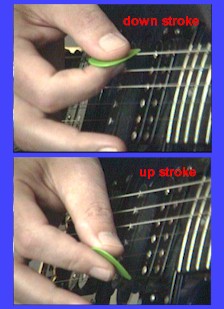
pattern 1

Lyle:
Let's use a C chord for this example.
C
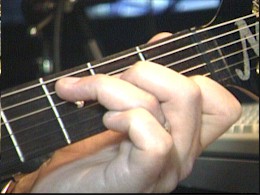
Lyle:
Add this simple Fmaj7 chord so you can make a 2 chord progression with these strum patterns.
Fmaj7
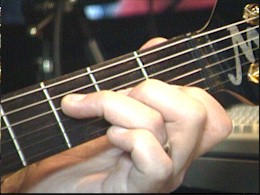
Lyle:
Jam along to this looping sound clip. It is 2 measures long starting with C for one measure then Fmaj7 for one measure.
Lyle:
Next pattern breaks up the continuous pattern from above. Look closely and you'll see the difference.
pattern 2

Lyle:
Notice that there are "holes" in the rhythm compared to pattern 1? This helps give the rhythm a bouncy feel, or more accent.
Lyle:
Use this jam track to practice pattern 2.
Lyle:
The next pattern is a bit tougher, but it sounds the best.
pattern 3

Lyle:
Notice where the down and up strokes are landing.
Lyle:
Here's a looping sound clip of me counting strum pattern 3:
Lyle:
Here's a jam track for this pattern again using the C and Fmaj7 chords.
Lyle:
The next pattern uses just the "up beats" or just the eighths of each beat. You can strum this pattern with all down or up strokes. I like all down at this slower tempo.
Lyle:
Learn these two new versions of the C chord and F chord for strum pattern 4...
Lyle:
Also, you'll palm mute the strings after each strum. The video clip should help you see this.
pattern 4

Lyle:
Jam along to this looping clip for strum pattern 4.
Lyle:
Now that you're familiar with these patterns, let's add a few more chords to make a 4 measure progression.
Here's Amin:
Am
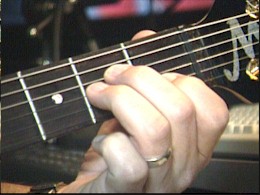
Lyle:
And here's an open G chord. Notice the use of all 4 fingers with this version.
G
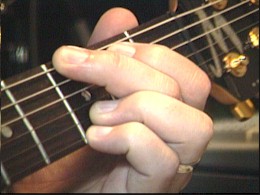
Lyle:
Here's the order of the 4 chords to use with the new jam track:
Lyle:
C - Fmaj7 - Am - G - one measure each.
Lyle: Ok, the new 4 chord jam track:
Lyle:
Now try playing strum pattern 1 with all 4 chords with this new jam track.
Here's the strum pattern 1 again:
pattern 1

Lyle:
Here's a sample of me playing this pattern.
Lyle:
Try strum pattern 2 with this chord progression.
pattern 2

Lyle:
Try strum pattern 3, my favorite.
pattern 3

Lyle:
...and try strum pattern 4, the Bob Marley pattern...
pattern 4

Lyle:
If you want to try improvising over this jam track, use the C major and C major blues scales.
Lyle:
Here's a new chord progression in the key of G.
Lyle:
Use the G chord from above. Then add Em7, A7sus4 and D chords:
Em7
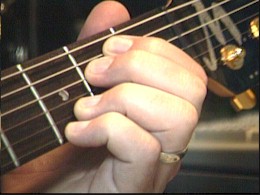
A7sus4
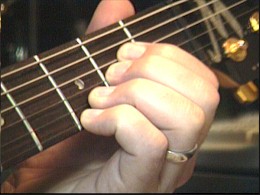
D
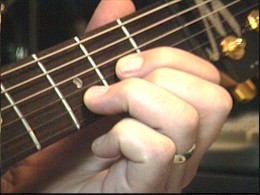
Lyle:
This new chord progression is:
G - Em7 - A7sus4 - D. Here's the new jam track:
Lyle:
Each chord gets 1 measure making up a 4 measure progression, like you did earlier.
Practice the strum patterns from above to this new chord progression. Here's a
few samples of me playing this new chord progression with each of the 4 patterns.
mao: Is there songs that use these progressions?
Lyle:
mao - yes, these are basic chord progression and strumming patterns, used all the time.
mao: Like the cranberries or something?
Lyle: Yes, and U2 and lots of country songs use rhythm patterns and progressions like these.
Lyle:
If you want to practice soloing over this jam, use a G major and the G major blues scales:
Lyle: At the very beginning of the lesson,
I posted an intro sample.mp3.
It used these chords and scales.
Lyle:
Practice counting out loud and tapping your foot to the beat.
Lyle:
That’s all for this lesson.
If you would like further study on this topic or any other topic, email me at
Lyle@theguitar.net for info on how you can get your own customized guitar
lessons like this using Riff Interactive technology. Your private lessons can be
downloaded to your pc for anytime, anywhere study. Thanks and see you at the
next lesson. - Lyle
|
<< load notation from left
|
|
<< load audio from left
|
<< load audio from left
|